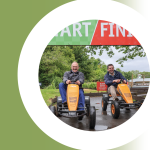
Dr Adam Behr
Reader in Music, Politics and Society at Newcastle University. Behr researches the connections between music, politics, the music industries, and cultural policy. This has included live music censuses, music sector mapping, work on the relationships between music and political campaigns, and investigations of digitisation, copyright, musical practice and regulation.
Twitter: @adambehrlive
Email: adam.behr@newcastle.ac.uk

UK Election 2024
Section 8: Personality politics and popular culture
87. Ed Davey: Towards a Liberal Populism? (Dr Tom Sharkey, Dr Sophie Quirk)
88. Why Nigel Farage’s anti-media election interference claims are so dangerous (Dr Lone Sorensen)
89. Nigel Farage and the political circus (Dr Neil Ewen)
90. Binface, Beany and Beyond: humorous candidates in the 2024 General Election (Prof Scott Wright)
91. What Corbyn support reveals about how Starmer’s Labour won big (Prof Cornel Sandvoss, Dr Benjamin Litherland, Dr Joseph Andrew Smith)
92. “Well that was dignified, wasn’t it?”: floor apportionment and interaction in the televised debates (Dr Sylvia Shaw)
93. TV debates: beyond winners and losers (Prof Stephen Coleman)
94. Is our television debate coverage finally starting to match up to multi-party politics? (Dr Louise Thompson)
95. Tetchiness meets disenchantment: capturing the contrasting political energies of the campaign (Prof Beth Johnson, Prof Katy Parry)
96. “We’re just normal men”: football and the performance of authentic leadership (Dr Ellen Watts)
97. ‘Make the friendship bracelets’: gendered imagery in candidates’ self-presentations on the campaign trail (Dr Caroline Leicht)
98. Weeping in Wetherspoons: generative Al and the right/left image battle on X (Simon Popple)
99. An entertaining election? Popular culture as politics (Prof John Street)
100. Changing key, but keeping time: the music of Election 2024 (Dr Adam Behr)
101. Truth or dare: the political veracity game (Prof John Corner)
For a general election where the result appeared to be a foregone conclusion in favour of ‘Change’, there was a strong element of continuity to its use of music.
There were echoes of the musical past from the outset. Anti-Brexit campaigner Steve Bray blasted out D:Ream’s ‘Things Can Only Get Better’ from a portable stereo to disrupt Rishi Sunak’s announcement of the election, a reminder of Tony Blair’s 1997 landslide, sending the song back up the charts.
There were, of course, important differences between 1997 and 2024 – the state of the economy most obviously, but also the mood of the electorate. Indeed, a sense of scepticism was echoed by D:Ream, who said they didn’t want any part of the campaign this time, and disavowed any future political uses of their hit. The headline of the band’s appearance at Glastonbury was, instead, an old-fashioned staple of band politics – the temporary reunion – as they were joined by famous ex-keyboardist Professor Brian Cox. Neither was there a repeat of the partisan football chanting that greeted Jeremy Corbyn in 2017, the festival acting as a barometer of a more uncertain approach in 2024 from its younger (and left leaning) demographic.
Party events nevertheless provided some opportunities for the parties to provide an element of popular cultural sheen to their campaigning and – denied the use of D:Ream – Labour still stuck with house music using 2022’s ‘Better Times’ by Låpsley and KC Lights as entrance music for a major campaign speech, to approval from the singer, Holly Fletcher, who noted her support for the party.
Other musicians’ endorsements, now a standing item in election campaigns, generally skewed towards Labour, including Guy Garvey, Beverley Knight, Ed Sheeran, and Elton John, who promoted Labour’s plans for culture. Massive Attack, meanwhile, backed the Greens with Holly Valance coming out for Reform.
It was an election where the most pointed challenges to Labour came not nationally, but locally, from independent or fringe-party candidates focused on specific issues – mostly the conflict in the Middle East. This was echoed amongst the heavy hitters weighing into the campaign. Ex-Pink Floyd frontman Roger Waters threw himself behind Craig Murray’s campaign in Blackburn, where he was standing for George Galloway’s Workers Party of Great Britain on a pro-Palestine ticket, and independents like Andrew Feinstein, who challenged Keir Starmer in the Holborn and St. Pancras constituency. Waters welcomed the further support of Eric Clapton – “El, my dear friend we stand together. Love you brother” – though neither Waters nor Clapton has an untainted record in progressive politics. Another issue-focused rocker was Brian May, with animal rights and opposition to hunting driving his intervention, this time in support of Labour.
Breakthrough musical moments also evidenced the continuing trajectory of individual candidates making use of the increased affordances of social media, and lower-cost production technology. Brent Labour MP Dawn Butler’s pastiche/cover of So Solid Crew’s ‘21 Seconds’, twenty-one days out from polling day, was a salient example of this although its perceived effectiveness depended very much on the existing predilections of viewers. Respondents to The Daily Telegraph deemed it “beyond embarrassing” while those for The Daily Mirror found it “hilarious” and “brilliant”.
Nigel Farage’s re-entry to frontline electoral politics was given a push by his presence on TikTok, his personal account outperforming those of the major parties, with the use of TikTok, and social media across the board, also meaning that the overall soundtrack was widely varied, enhancing the wider use of meme culture in the musical components of the campaign, rather than standout anthems. The major parties, for instance, used snippets of music for comedic effect. Labour deployed a slurred rendition of Grieg’s ‘Peer Gynt’ to represent Conservative dysfunction, the tune becoming clear on the appearance of the ‘Change’ logo. A Tory video, meanwhile, deployed hot jazz behind a roulette wheel to urge voters not to bet on Labour, also with a ‘mangled-tape’ effect at the end. (In part of a generally maladroit campaign, they launched this just after a major gambling scandal broke around Conservative staff betting on the election date). Meme culture, also a standing fixture now, found its way into the campaign, with ‘lo-fi swinneywave beats’ from the SNP, and an hour long YouTube animated loop from the Conservatives warning about Labour tax plans to a dance music beat.
Amongst this plethora, the mainstream broadcast messaging from the parties themselves continued the trend of recent years towards smoothly integrated, but musically indistinct, soundtracks to the Party Election Broadcasts. This was advertising music and underscore, as opposed to a central part of the message. In fact, the most notable sonic feature in any of the broadcasts was Reform’s choice to use complete silence for one of theirs.
The general musical tone, then, was characterised by variety – especially across individual candidates, and social media – but the lack of a cohesive sound from any of the parties. With the electorate’s choice seemingly in the bag, it was more a case of background music than theme song.
